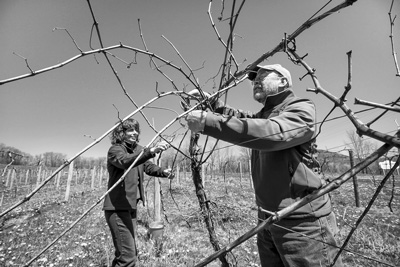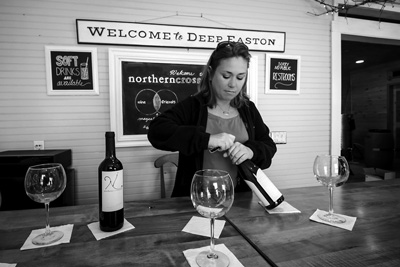Arts & Culture May 2016
N.Y. wine country expands to north
Cold-hardy grapes, simpler regulations allow vineyards to thrive
 By EVAN LAWRENCE
By EVAN LAWRENCE
Contributing writer
EASTON, N.Y.
Vineyards and wineries have lately been spreading northward in the Hudson River valley and beyond, spurred by the advent of new, cold-hardy grape varieties, a booming interest in locally produced food and drink, and newly simplified state regulations.
The result is a proliferation of new producers even in North Country counties that used to be considered unsuitable for wine production.
“Traditional European grapes won’t grow here,” explained Gerry Barnhart, co-owner of Victory View Vineyard in Schaghticoke and a founding member of the Upper Hudson Valley Wine and Grape Association.
 But new grape varieties developed by the University of Minnesota and Cornell University starting in the mid-1990s “made it possible to grow grapes that will make good wines,” he said.
But new grape varieties developed by the University of Minnesota and Cornell University starting in the mid-1990s “made it possible to grow grapes that will make good wines,” he said.
The cold-hardy grapes, with names like Marquette, La Crescent, Frontenac, La Crosse, and Cayuga White, “are disease resistant, tolerate freezing, and have the flavor and taste of vinifera grapes,” said Kate Taylor, owner of Galway Rock Vineyard and Winery in Saratoga County and the association’s president.
Barnhart said the muggy summers of eastern New York promote fungal diseases that are damaging to European grapes.
Mary and Gerry Barnhart of Victory View Vineyard, top, and Kathleen Weber, of North Cross Vineyard, above, are among more than a dozen new winemakers in New York’s upper Hudson River region.Joan K. Lentini photos
But with the new varieties, “fungal diseases can be managed,” he said. “It just takes some effort.”
The Upper Hudson Valley Wine and Grape Association began in 2008 as an informal group of grape and wine enthusiasts, Barnhart said.
Formally organized in 2010, the group now includes 14 vineyards, wineries, and wine bars in Saratoga, Warren, and Washington counties, with several new vineyards expected to join over the next two years as they come into production, Taylor said.
Vineyards grow grapes, while wineries turn the grapes into wine. Many of the association’s members both grow their own grapes and bottle them, although they may combine their harvest with grapes from the Finger Lakes region or Long Island. Wines from Upper Hudson wineries have won honors at competitions including the 2016 Finger Lakes International Wine Competition, the 2016 International Eastern Wine Competition, and Critics Challenge International Wine and Spirits Competition.
Agricultural tourism
Wine is a big industry in New York, which ranks third in U.S. production. The New York State Wine and Grape Foundation estimated that in 2008, there were nearly 5 million wine-related tourist visits to the state, generating about $376.5 million in economic activity. State Division of Tourism studies have concluded that winery and brewery visits draw as many people as hiking, biking, camping and boating.
Gov. Andrew Cuomo has been a big booster of the state’s craft beverage producers. In 2014, acting on recommendations that came out of wine, beer, spirits, and cider summits in 2012 and 2014, Cuomo signed the Craft New York Act. The law eased regulations on small wineries, breweries, and distilleries, created a single office to handle all inquiries about state regulations and programs related to craft beverage production, and allocated $5 million for tourism promotion, advertising and matching grant funds for business development.
Recent legal changes also allowed local wineries to sell their products at farmers markets as well as from the vineyard.
“The Craft New York Act changed quite a bit of how things are done,” said Karen Gardy, owner of Brookview Station Winery in Castleton and director of marketing for the Hudson-Berkshire Beverage Trail, which covers producers in Columbia, Berkshire and southern Rensselaer counties. “The state rewrote a lot of regulations for distilleries and breweries and simplified a lot of things.”
Many of the region’s vineyards “were started as a result of the craft beverage initiative,” said Kathleen Weber, co-owner of Northern Cross Vineyard in Valley Falls. “That’s when the rules started changing. It made it easier to be a small producer.”
The local food movement has sent consumers searching avidly for small-batch, high-quality food and drink produced close to home. These customers are often willing to pay more for locally produced wines.
“It’s definitely a big help to the emerging wine industry,” Barnhart said.
Getting started
Weber said growing wine grapes “is something you can do agriculturally that’s profitable.” But it is not particularly easy, nor it is for those who want a quick return on their investment.
Barnhart said the right land is essential.
“Grapes need a good site with water and air drainage and good sun,” he explained. “A southerly aspect helps.”
Vines take three years to produce their first crop, and fermentation requires another six months before the wines are ready to sell. Necessary equipment may include farm tools and machinery, fermentation vats, bottling equipment, bottles, and buildings to house them and the wine. Vintners need federal and state licenses and may have to meet local regulations on alcohol production and sale.
“Permitting can take up to a year,” Taylor said.
But a growing number of entrepreneurs in the Upper Hudson region are taking the leap. Like its Hudson-Berkshire counterpart to the south, the Upper Hudson Valley Wine and Grape Association started a wine trail in 2013 as a way to market its members’ products. The Upper Hudson trail does not yet have state recognition, however.
New York has 15 official beverage trails and a cheese trail. State designation would allow the Upper Hudson trail to use standard state wine trail signs and give it access to state marketing funds and programs.
Festivals and tasting tours
The Hudson-Berkshire Beverage Trail is the only trail in the state that crosses state lines. It links four wineries and four distilleries, two of them in Massachusetts. It started in 2008 or 2009 with two wineries and a distillery -- the minimum number -- and has grown from there, Gardy said. It was recently named one of the country’s top five drinking trails by Paste magazine.
“The trail has been well received,” Gardy said. “It’s brought so much to the region. All of a sudden, there was a trail you didn’t have to drive hours to reach.”
One of its advantages is its nearness to favorite tourist spots in the Berkshires, she added.
“What a draw to have so much Connecticut and Massachusetts business coming into the area,” Gardy said.
The Hudson-Berkshire Beverage Trail hosts an annual Wine & Food Festival at the Columbia County Fairgrounds in Chatham. This year’s event, the fourth, will be held on the weekend of May 28-29.
“The fest has grown by leaps and bounds,” Gardy said. “It brings people that wouldn’t necessarily be coming to New York.”
The Upper Hudson Valley Wine Trail has its own events; its third annual Wine and Cheese Weekend will be May 14-15 in the tasting rooms of its member wineries. Nine wineries will pair three of their wines with three locally produced cheeses.
The Adirondack Wine and Food Festival, in Lake George, comes up on June 25-26, with more than 50 New York wineries, breweries, and food vendors participating.
Seeking wider recognition
Upper Hudson grape growers and wine makers have even bigger ambitions. Fifteen growers in an area stretching from Schoharie County to the Vermont state line, and from Glens Falls to Altamont, created the Upper Hudson American Viticultural Area Development Council to attract customers to the area and promote the vineyards.
Weber and her husband, Andrew, recently submitted an application to the U.S. Alcohol and Tobacco Trade and Tax Bureau, which regulates wine production and sales at the federal level, for designation as an American Viticultural Area.
The growers want the federal agency to declare their wines distinctive enough to warrant their own regional label. For example, a bottle of red wine made entirely with Marquette grapes from the region could be labeled “Upper Hudson Marquette.” That would give it a marketing edge over other Marquette wines, and the Webers say it would protect local wines.
“This is the single most important event to promote the wine region,” Andrew Weber said. “This establishes the foundation for regional vineyards to develop a product.”
Approval of the application is expected in 2017, the Webers said.
The next step will be state approval of an Upper Hudson wine trail.
“It will help hotels, restaurants, and tourism,” Kathleen Weber said. “We want people to stay and eat here. It’s not just about wine.”
“There’s sort of a romance about having a vineyard,” she added.
But growing and harvesting grapes is also a lot of work. Their harvest in September and October is a communal effort.
“The weather is gorgeous, and we have great views,” Weber said. “People come to help and become customers. Everyone eats together in the barn. It helps bring customers back, because they’ve had a hand in the whole process.”
For more information about local wine trails, their member businesses and events, visit www.upperhudsonvalleywinetrail.com and www.hudsonberkshireexperience.com.

